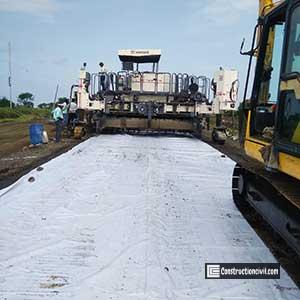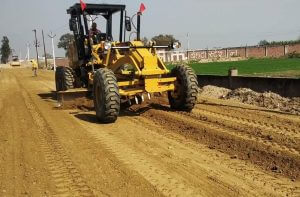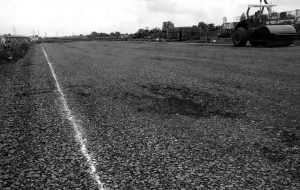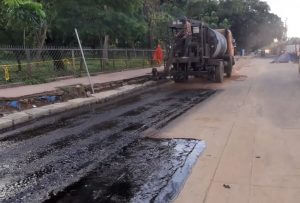The rigid pavement is a pavement type with sufficient flexural strength to transmit the wheel load stresses to a broader area below. Compared to the flexible pavement, rigid pavements are placed either directly on the prepared sub-grade or a compacted granular subbase(GSB) layer depending upon the design requirements. In the case of rigid pavement, there is only one layer of material between the Pavement Quality Concrete (PQC) and the sub-grade, known as the concrete subbase course.
What is DLC?
Dry lean concrete (DLC) works as a concrete subbase course over which pavement quality concrete slabs rest.
Also, Read: Prime Coat and Tack Coat using Cationic Bitumen Emulsion for Road Work
Concrete Subbase Course(DLC) mixing ratio:
As per MoRTH, the mix shall be proportioned with a maximum aggregate cement ratio of 15:1. The DLC mix’s optimum water content shall be determined and confirmed by rolling during trial patch construction. The authority shall approve the optimum moisture content and degree of compaction after trial patch construction. During main construction, the lean concrete shall have a moisture content between the optimum and optimum +2%, keeping in view the effectiveness of compaction achieved and compensating for evaporation losses.
The concrete subbase course minimum cement content shall be 150 kg/cum of concrete. If fly ash is blended (not more than 20% by weight as part replacement of cement), the content of OPC shall not be less than 135 kg/cum.
Concrete Strength of DLC:
As per MoRTH Clause 903.5.1.1, each consecutive group of 5 cubes’ average compressive strength should not be less than 10.0MPa at seven days. Besides, any individual cube’s minimum compressive strength shall not be less than 7.5 MPa at seven days.
Also, Read: What is Pavement Quality Concrete? – PQC Construction Method
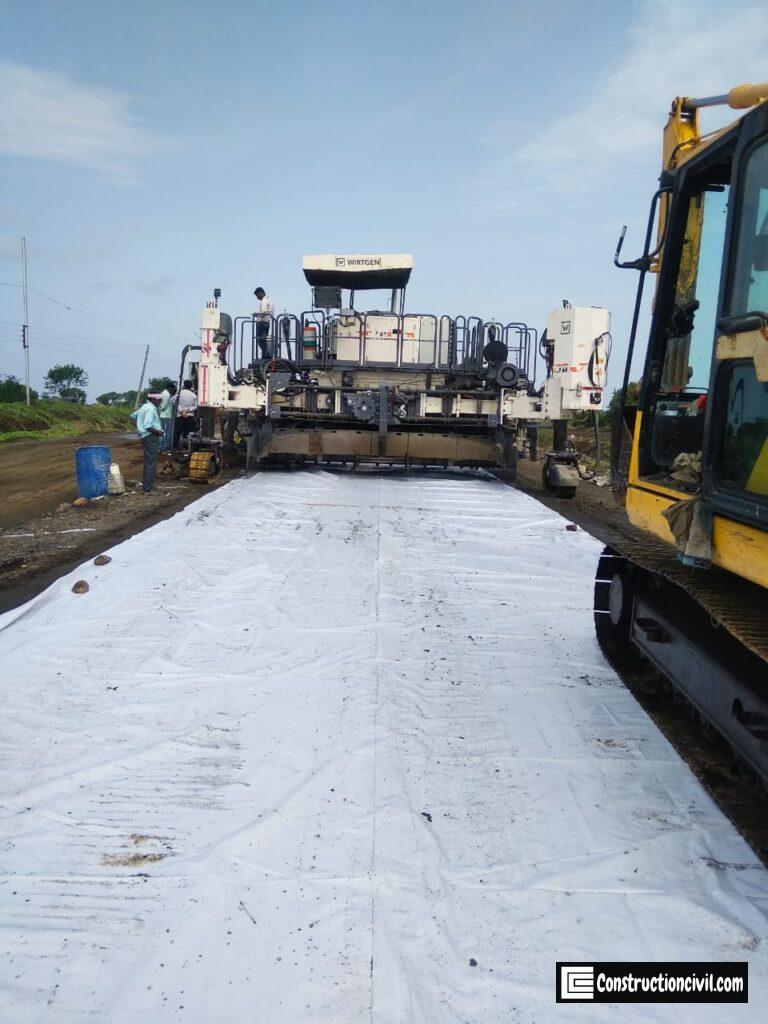
Also, Read: Properties of Concrete – Introduction to Good Concrete Practice
Gradation for Concrete Subbase Course.:
MoRTH, Table 600-1 Aggregate Gradation for Dry Lean Concrete:
| Sieve Designation | Percentage by weight passing the Sieve |
| 31.5 mm | 100 |
| 26.50 mm | 90-95 |
| 19.0 mm | 80-90 |
| 9.50 mm | 55-75 |
| 4.75 mm | 35-60 |
| 600.00 micron | 10-35 |
| 75.00 micron | 0-8 |
Also, Read: Road Construction Materials – Test Frequency and Acceptance Criteria
DLC Construction:
Construction of Overlays on the Existing Rigid Pavement:
- Level shall be taken at 10-meter intervals at least three points(either edge and centre line) of the entire width along the existing rigid pavement to assess the profile corrective course requirement.
- Existing pavement shall be cleaned thoroughly by mechanical broom or manually as per the site condition.
- All the cracks/worn out surfaces shall be examined thoroughly for their severity.
- All the cracks that will not hamper the pavement’s structural stability will be repaired with an approved brand’s Epoxy. We have to dismantle the whole panel if the severity of the cracks is high during the investigation.
- A Profile corrective course with approved Dry Lean concrete/concrete subbase course mix shall be done matching with FRL after repairing cracks in the existing pavement and rectification of structurally weak panel.
- Before carrying out any profile corrective course, it shall be ensured that all treatment done on the existing pavement has gained the proper strength to receive the overlay.
- Concrete subbase course shall be prepared in a fixed automated plant and hauled in end dumpers from plant to the site.
- All profile corrective course shall be done in layers, and placing of material will be done by paver/grader or manually as per the site condition.
- Compaction of Dry Lean concrete/concrete subbase course mix will be done with a Vibro roller (Double drum) of 10Tonnes capacity to achieve density not less than 97% of the laboratory density and not less than 95% at 0.5 meters from the edge. Wherever space will be a constraint for significant Vibro roller movement, we may use a small vibro roller without compromising with the compaction.
- We have to measure each layer of the laid profile corrective course’s compaction with the help of a Nuclear Density Gauge.
- After compaction of the DLC’s final layer (Profile corrective course), we have to cover the whole surface with wet gunny bags for seven days.
- Drilling of the hole as per the approved drawing shall be completed after three days of laying profile corrective course, ensuring full depth of PCC and half depth of existing rigid pavement.
- Vertical dowel bars of 32 mm dia shall be inserted into the drilled hole and further anchored with a grouting compound. We shall decide the length of bars to be inserted into the full drilled depth and embedded at least 150mm in the overlaid Pavement Quality Concrete(PQC).
Also, Read: Design Mix of Concrete – Detailed Procedure With Calculation
Construction of New Pavement:
- After checking the top of subgrade levels, GSB of the compacted thickness of 150mm shall be laid in throughout the width. Relative compaction of GSB shall be checked with NDG and shall be ensured to 98% of laboratory density.
- DLC of the compacted thickness of 150mm for the new lane shall be laid as stated above for existing pavement.
- Quality control shall be done similar to laying of Dry Lean concrete/concrete subbase course for the existing pavement.
- Approved Curing compound shall be sprayed after compaction of DLC. Moist hessian shall be covered immediately after cessation of the curing compound’s tackiness and shall be kept moist for seven days.
Also, Read: Determination of Sieve Analysis For Fine Aggregate
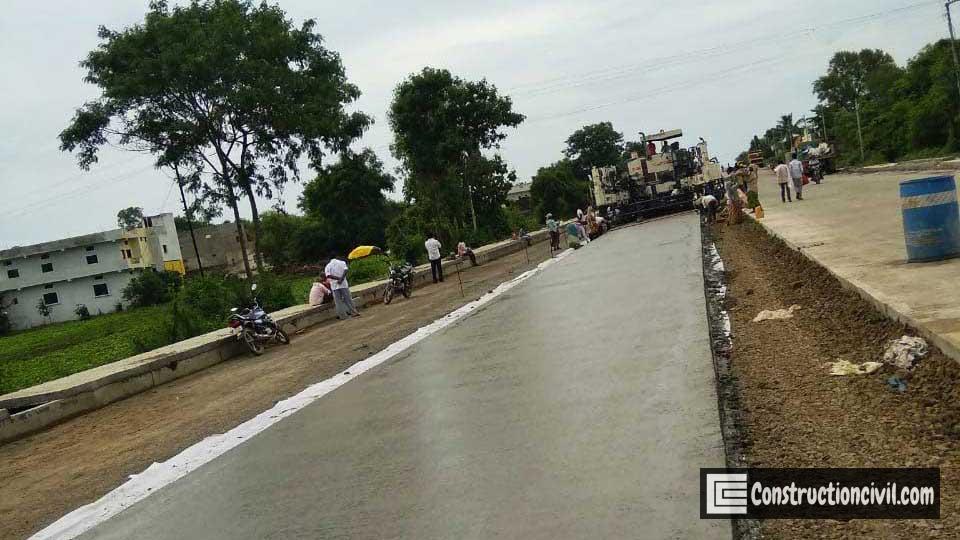
Also, Read: Concrete Ingredients – Important Properties and Tests
Dry Lean Concrete(DLC) Joints:
- The construction joint should be a transverse butt type.
- Transverse joints in Dry Lean concrete shall be staggered by 800-1000 mm.
- When full-width paving is not possible, we have to provide a longitudinal construction joint.
- The longitudinal joint in Dry Lean Concrete shall be staggered by 300-400 mm.
Advantages оf Dry Lean Concrete(DLC):
- Dry Lean Concrete(DLC) Provides an even and more robust base to the Pavement Quality Concrete (PQC).
- It provides resistance to the deformation of concrete pavement.
- DLC gives greatly improved load transfer efficiency at the PQC joints.
- There is a final reduction in Pavement Quality Concrete’s depth due to the DLC as a base layer.
Reference:
- IRC specification: SP-49: 1998
- MoRTH, 5th Revision
Also, Read: Nondestructive Testing of Concrete – Methods & Guidelines
